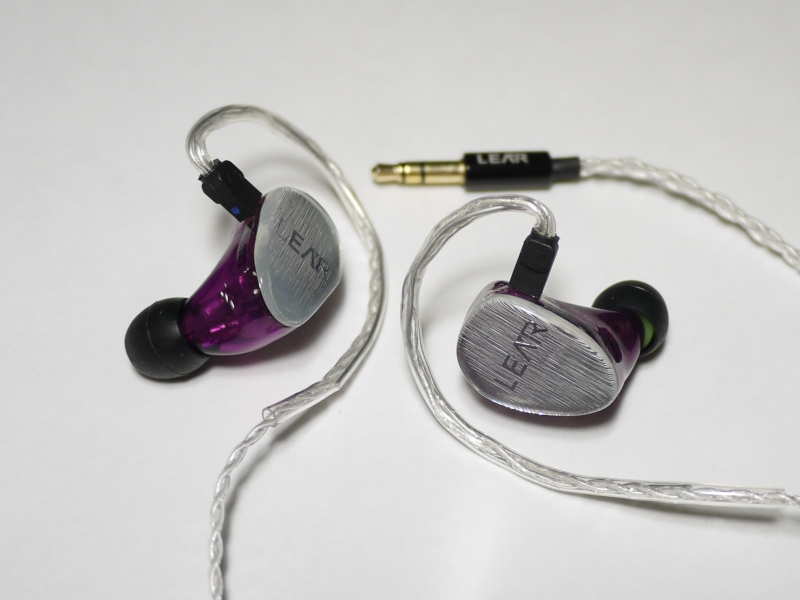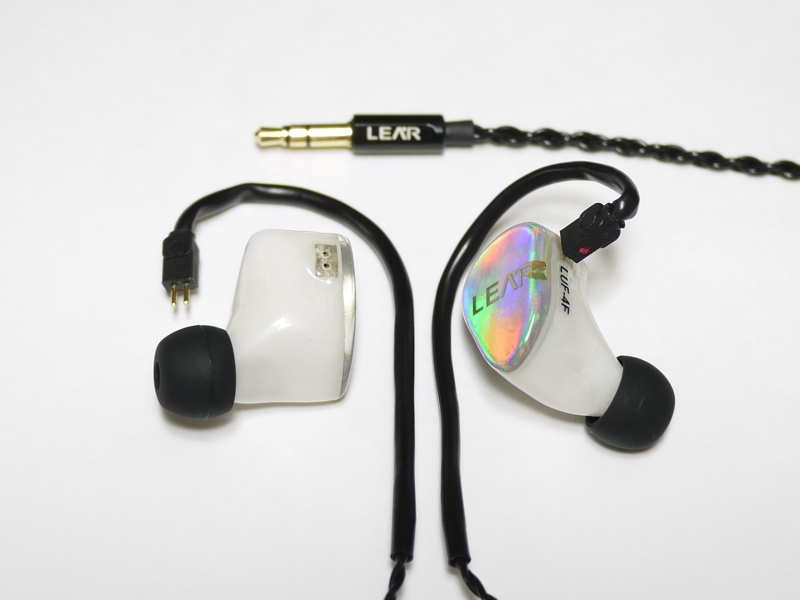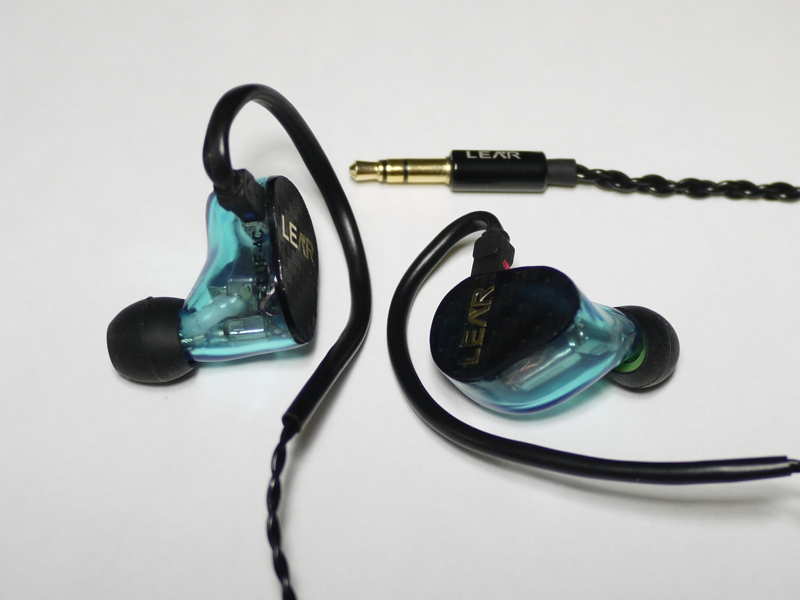
LEAR LUF-4 in transparent purple with “metallic” faceplates
Details: custom-made universal IEMs from Hong Kong-based LEAR
MSRP: HKD 4,388 (approx. $565) (manufacturer’s page)
Base Price: HKD 4388 (approx. $565) from lear-shop.com / SGD 899 (approx. $620) from treoo.com
Specs: Driver: Quad BA | Imp: 22Ω (4B), 28Ω (4F/4C) | Sens: 120 dB | Freq: 20-20k Hz | Cable: 3.9′ I-plug
Nozzle Size: 5mm | Preferred tips: Sony MH1C tips, MEElec M6 single-flanges, stock single-flanges, stock foam
Wear Style: Over-the-ear
Accessories (5/5) – Hybrid-style single-flange (3 pairs), bi-flange, and triple-flange silicone tips, Comply-style (1 pair) and generic (1 pair) foam tips, cleaning tool, cleaning cloth, Otterbox crush- and water-proof carrying case, and soft carrying pouch
Build Quality (5/5) – The LUF-4 earphones are essentially custom monitors cast in a universal mold. Build quality is on-par with high-end CIEMs, as are the customization options. Two types of detachable cable sockets are offered – conventional 2-pin is standard, with MMCX available at extra cost. There are more than a dozen options for shell and faceplate colors, and the faceplates can be upgraded to a different material – anything from wood to metal to denim – or outfitted with custom artwork, at an extra cost
Isolation (4/5) – Isolation is impressive thanks to the hefty shells, long nozzles, and ergonomic design
Microphonics (5/5) – No cable noise with the twisted cables
Comfort (4/5) – The housings of the LUF-4 earphones are large, but the bulk is msotly in their thickness, making for one of the more comfortable custom-come-universal designs out there (alongside Noble Audio’s universal-fit offerings). The longer nozzles allow the shells to sit comfortably without fatigue, and while the earphones do still require larger ears, they have a smaller footprint than, say, a FitEar TG334, StageDiver SD-2, or Shure SE846
Sound (9.3/10) – The LUF in LUF-4 stands for LEAR Universal Fit, and is the universal interpretation of LEAR’s pricier LCM-4 series customs. Unlike other custom-come-universal earphones, however, the LUF-4 models remain fully customizable, starting with the sound. There are three tunings available, as follows:
- LUF-4F “Flat”
- LUF-4B “Bass” (enhanced bass)
- LUF-4C “Crystal Clear” (enhanced treble)
The LUF-4 models each have four drivers in a rather unique 3-way configuration – 1 low, 2 mid, 1 high – and utilize a dual-bore design with metal sound tubes.
The three tunings have a lot in common and only differ a little in sound profile. The LUF-4B model, for instance, is quite a bit more impactful than the LUF-4F, but otherwise pretty much identical. As expected, the extra bass makes it sound warmer and towers over the mids a bit more, but bass quality is still very good and not much changes overall compared to the 4F.
The LUF-4C boasts a brighter top end compared to the LUF-4F and 4B. As expected, this makes the sound seem somewhat clearer, but treble quality is maintained – the 4C is no harsher or more sibilant than the 4F. In the real world, the tuning of the 4C results in the perception of slightly lower bass quantity, also making the 4F and 4B seem warmer in comparison.
Since the LUF-4 earphones are more similar to each other than they are different, throughout the following write-up I am referring to the LUF-4F unless otherwise noted.
Despite the fact that the F in “4F” stands for “flat”, the LUF-4F is a slightly v-shaped earphone (all three of the LUF-4 tunings are) and its bass is somewhat enhanced. All of the LUF-4 earphones sound quite a bit punchier compared to sets such as the TDK BA200 and more analytical BA-based earphones such as the Rock-It Sounds R-50 and VSonic VC1000. The bass power of the LUF-4F is below Dunu’s hybrid DN-2000 model, which has a separate dynamic driver for bass. The low end of the LUF-4B, however, is more powerful than that of the DN-2000, but also tighter and more controlled. The DN-1000, Dunu’s lower-end hybrid, is bassier still, providing a warmer, thicker, and more full-bodied sound, but cannot keep up with the LUF-4 earphones in bass quality.
The mids of the LUF-4 earphones fall slightly behind the bass in emphasis, creating a mildly v-shaped sound signature. As a result, “reference” earphones such as the TDK BA200 sound more mid-centric in comparison. Nonetheless, the mids on the LUF-4 sets are not as thin and recessed as they are, for example, on T-Peos’ Altone200 hybrid. The treble emphasis of the LUF-4 earphones also provides superb perceived clarity – better than that of the BA200 and DN-1000 and on-par with brighter, faultlessly clear sets such as the Altone200 and Rock-It Sounds R-50.
All of the LUF-4 earphones have quite a bit of presence in the upper midrange and lower treble. This type of tuning usually sounds best at reasonable volumes, and the LEAR units are no exception – as the volume is turned up, they get somewhat bright. Compared to the Dunu DN-2000, which uses a hybrid driver setup, the LUF-4F and 4B are not brighter overall, but the emphasis falls in the upper midrange and lower treble. With the Dunu unit, the treble energy is higher up, and as a result the earphone sounds smoother and more forgiving on some tracks.
The presentation of the LEAR units is on-par with other top-tier IEMs – well-imaged and spacious enough not to sound congested even with the enhanced-bass LUF-4B tuning. The Dunu DN-1000, for instance, is more intimate and not as open-sounding, whereas the popular VSonic GR07 lacks the depth and more versatile imaging of the LEAR units.
Select Comparisons (Note: in each comparison the LUF configuration with the best signature match was selected)
VSonic GR07 ($99) (vs. LEAR LUF-4F)
VSonic’s GR07 is a long-time favorite benchmark of mine, and with the latest version priced at just $99, will likely remain one for years to come. The LUF-4F made for the closest signature match here, with bass that is just a touch less impactful and full-bodied than that of the dynamic-driver VSonics and the most similar treble energy.
The biggest difference is in how veiled and muffled the midrange of the GR07 sounds next to the LEAR unit – there’s just no comparing the clarity between them. The LUF-4F is also significantly more sensitive, and while it has a little more upper midrange presence, it is still a touch less sibilance-prone than the VSonic set. Overall, the GR07 keeps up with the LUF-4F in several ways – bass quality, for example, is excellent on both units – but the clarity deficit is just too great to overcome.
InEar StageDiver SD-2 ($449) (vs. LEAR LUF-4F)
InEar’s custom-come-universal StageDiver SD-2 is a “mere” dual-driver, but one that offers a remarkably balanced and coherent sound. The bass of the LUF-4F is more powerful than that of the SD-2, but not emphasized enough to match up with the pricier (and more bass-heavy) SD-3 model.
As expected, the less bassy SD-2 sounds just a hair tighter than the LUF-4F. It also has flatter, more forward-sounding mids than the somewhat v-shaped LEAR. The LUF-4F has stronger upper mids, providing more emphasis in the “presence” region for electric guitars and appearing a little clearer overall. At the top, the StageDiver 2 is smoother and significantly more forgiving while the LUF-4F is brighter. The SD-2 has a wide and spacious soundstage but seems to lack some of the depth of the LUF-4F.
Westone W40 ($500) (vs. LEAR LUF-4F)
First off, compared to the fully customizable LUF-4F, the interchangeable red, blue, and black plastic shell inserts of Westone’s quad-driver model are rather unimpressive. Its sound, thankfully, is more competitive.
Overall bass quantity is similar between the two units, but the LUF-4F tends to sound a little tighter, with less bleed into the lower midrange. The mids of the W40 are less clear, even muffled, in comparison. The difference stems not only from the tighter bass of the LUF-4F, but also from the W40 having an upper midrange dip where the LEAR unit has emphasis. Forward vs. recessed upper mids make a very big difference on certain tracks, especially with vocals and especially at lower volumes.
The brighter, clearer LEAR unit is not as forgiving as the Westone, tending towards harshness, but both units have similarly well-rounded presentations. Tonally, both units are slightly short of perfect, with the W40 losing out thanks to its darker sound with more recessed upper mids and the LUF-4F – for moving too much in the opposite direction. Overall, however, I found myself preferring the LUF-4F, especially at lower volumes.
EarSonics SM64 ($499) (vs. LEAR LUF-4B)
The EarSonics SM64 is closest to LEAR’s enhanced-bass tuning, but tonally warmer and darker. The LUF-4B is more v-shaped, making it more prone to harshness and sibilance. Partly due to the brighter tonality, the LEAR unit is slightly clearer, but the clarity of the SM64 is still impressive considering its smoother sound and lower upper midrange energy. Vocals are still clear and highly intelligible with the EarSonics.
It’s worth noting also that the LEAR LUF-4B is much more sensitive. Overall, it is quite hard to pick between these two, but at lower volumes I found the LUF-4B preferable as the clarity boost makes a bigger difference and its extra upper mid/treble energy is kept in check. At high volumes, however, the smoothness of the SM64 made it very compelling.
AKG K3003 ($1300) (vs. LEAR LUF-4B)
AKG’s ultra-pricy hybrid flagship also has three available tunings, albeit in the form of interchangeable nozzle filters, of which I prefer the middle “Reference” configuration. The enhanced-bass LUF-4B is closest to the dynamic-driver bass of the AKGs, though the K3003 still provides a little more bass impact and a more full-bodied sound with the LUF-4B sounding thinner in comparison.
Clarity is similarly excellent between the two earphones, but LUF-4B doesn’t suffer from the slight lack in coherency of the hybrid system. It does have a little more energy at the top end, however. The K3003 has never been one to disappoint for lack of treble presence, but its sparkle comes from some well-controlled peaks whereas the LEAR has a general upper midrange/treble lift, causing it sound brighter and also making it a bit more prone to harshness and sibilance.
Etymotic Research ER4S ($299) (vs. LEAR LUF-4C)
All of the LUF-4 earphones sound a little v-shaped on the whole, but the least bassy LUF-4C made for the best comparison with the ER4S. The 4C unit still offers quite a bit more bass punch and sounds warmer due to the greater low end emphasis, but not as much as the other LUF-4 variants. The bass of the ER4S is a little gutless in comparison, as it tends to be next to bassier earphones.
The ER4S is not as full-bodied as the LUF-4C, but is also flatter and more balanced overall, with more midrange presence compared to the somewhat v-shaped LUF-4C. The LUF-4C is a touch less forgiving, but overall treble quality is similar. The LEAR unit has a more 3-dimensional presentation, which, admittedly, has never been a strong suit of Etymotic earphones.
Olasonic Flat-4 Nami ($499) (vs. LEAR LUF-4C)
Olasonic’s Flat-4 earphones utilize a dual dynamic driver configuration, but – surprisingly – are tuned for a little less bass impact than the BA-based LUF-4C. The LEAR unit has a stronger low end and more full-bodied sound. Both earphones have excellent clarity but the thicker note presentation of the LUF-4C is a little more natural. The Flat-4 is a bit brighter and can be slightly harsher, but ultimately neither earphone is very forgiving. In terms of presentation, the Flat-4 Nami sounds a little more airy and open, but the LUF-4C is more well-rounded and three-dimensional.
Value (8/10) – The LEAR LUF-4 models offer a competitive, yet well-differentiated alternative to more mainstream multi-BA earphones. The three slightly different takes on a v-shaped sound signature are consistent with each other, yet each delivers exactly what it promises without significant downsides compared to the “flat” 4F tuning. The unprecedented level of customization for universal IEMs is noteworthy as well – certainly a draw for those planning to spend over $500 on a set of in-ears.
Pros: Unprecedented customizability among universal-fit earphones; superb craftsmanship; excellent bass quality and clarity
Cons: Best suited for fans of v-shaped sound signatures; top-end emphasis can be too much at high volumes

LEAR LUF-4 in opaque white with “illusion/imaginary color” pearlescent faceplates

LEAR LUF-4 in transparent light blue with black “true texture” carbon fiber imitation faceplates


